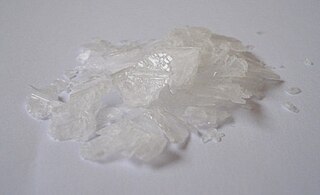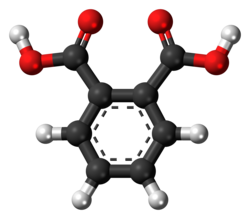Top Qs
Timeline
Chat
Perspective
Phthalic acid
Aromatic organic compound with formula C6H4(COOH)2 From Wikipedia, the free encyclopedia
Remove ads
In organic chemistry, phthalic acid is an aromatic dicarboxylic acid, with formula C6H4(CO2H)2 and structure HO(O)C−C6H4−C(O)OH. Although phthalic acid is of modest commercial importance, the closely related derivative phthalic anhydride is a commodity chemical produced on a large scale.[4] Phthalic acid is one of three isomers of benzenedicarboxylic acid, the others being isophthalic acid and terephthalic acid.
Remove ads
Production
Phthalic acid is produced by the catalytic oxidation of naphthalene or ortho-xylene directly to phthalic anhydride and a subsequent hydrolysis of the anhydride.[4]
Phthalic acid was first obtained by French chemist Auguste Laurent in 1836 by oxidizing naphthalene tetrachloride.[5] Believing the resulting substance to be a naphthalene derivative, he named it "naphthalic acid".[5][6][7] After the Swiss chemist Jean Charles Galissard de Marignac determined its correct formula,[8] Laurent gave it its present name.[5][9][10] Manufacturing methods in the nineteenth century included oxidation of naphthalene tetrachloride with nitric acid, or, better, oxidation of the hydrocarbon with fuming sulfuric acid, using mercury or mercury(II) sulfate as a catalyst.
Remove ads
Synthesis
Naphthalene, on oxidation with potassium permanganate or potassium dichromate, gives phthalic anhydride,[citation needed] which, through hydrolysis with hot water, gives phthalic acid.[11] A more standard procedure is to oxidize napthalene with air, but this reaction proceeds explosively unless conditions are set up very accurately.[12]
Uses
Phthalic acid in the form of phthalic anhydride is an important industrial chemical, used for making phthalates (esters of phthalic acid) that are used as plasticizers. However, phthalic anhydride is usually not made by dehydration of phthalic acid but from p-xylene or naphthalene.
Reactions

It is a dibasic acid, with pKas of 2.89 and 5.51. The monopotassium salt, potassium hydrogen phthalate is a standard acid in analytical chemistry. Phthalate esters are typically prepared from the widely available phthalic anhydride. Reduction of phthalic acid with sodium amalgam in the presence of water gives the 1,3-cyclohexadiene derivative.[13]
Safety
The toxicity of phthalic acid is moderate with LD50 (mouse) of 550 mg/kg.
Biodegradation
The bacteria Pseudomonas sp. P1 degrades phthalic acid.[14]
See also
References
External links
Wikiwand - on
Seamless Wikipedia browsing. On steroids.
Remove ads





